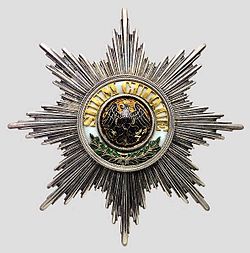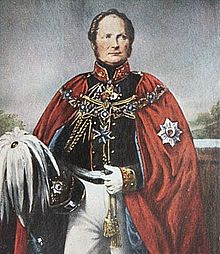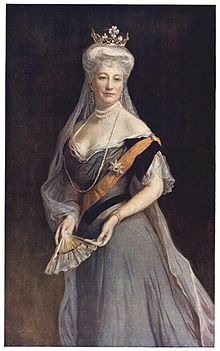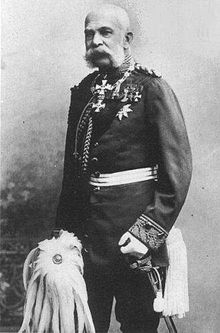- Order of the Black Eagle
-
Order of the Black Eagle (Schwarzer-Adler-Orden)
Order of the Black Eagle breast star with the motto SUUM CUIQUE (idiomatically, "to each according to his merits") in the medallion's centerAwarded by the Kingdom of Prussia Type Chivalric order Eligibility Members of ruling houses, senior civil and military officials and other worthy figures appointed by the King of Prussia. Awarded for Civil or military merit Status Obsolete Description Badge of the order worn from a sash over the recipients left shoulder a black and white ribbon around the neck or from a chain around the neck; breast star worn on the left chest. Motto Suum Cuique (idiomatically, "to each according to his merits") Statistics Established 17 January 1701 First awarded 1701 Last awarded 1918 Total awarded 407[1] Precedence Next (higher) None Equivalent None Next (lower) Order of the Red Eagle The Order of the Black Eagle (German: Hoher Orden vom Schwarzen Adler) was the highest order of chivalry in the Kingdom of Prussia. The order was founded on 17 January 1701 by Elector Friedrich III of Brandenburg (who became Friedrich I, King in Prussia, the following day). In his Dutch exile after WWI, deposed Emperor Wilhelm II continued to award the order to his family. He made his second wife, Princess Hermine Reuss of Greiz, a Lady in the Order of the Black Eagle.
Contents
Overview
The statutes of the order were published on 18 January 1701, and revised in 1847. Membership in the Order of the Black Eagle was limited to a small number of knights, and was divided into two classes: members of reigning houses (further divided into members of the House of Hohenzollern and members of other houses, both German and foreign) and capitular knights. Before 1847, membership was limited to nobles, but after that date, capitular knights who were not nobles were raised to the nobility (Adelstand).[2] Capitular knights were generally high-ranking government officials or military officers.
The Order of the Black Eagle had only one class, but could also be awarded at the king's prerogative "with the Chain" ("mit der Kette") or without ("ohne Kette"). By statute, members of the order also held the Grand Cross of the Order of the Red Eagle, and wore the badge of that order from a ribbon around the neck. From 1862, members of the Prussian royal house, upon award of the Order of the Black Eagle, also received the Prussian Crown Order 1st Class.[3]
Insignia
The badge of the Order was a gold Maltese cross, enamelled in blue, with gold-crowned black eagles between the arms of the cross. The gold center medallion bore the royal monogram of Friedrich I ("FR", for Fredericus Rex).
This badge was worn from either a broad ribbon (or sash) or a collar (or "chain"). The ribbon of the Order was an orange moiré sash worn from the left shoulder to the right hip, with the badge resting on the hip. The collar or chain (Kette) was worn around the neck and resting upon the shoulders, with the badge suspended from the front center; the collar had twenty-four elaborate interlocking links: alternatively a black eagle and a device featuring a center medallion with the motto of the Order (Suum Cuique -- literally "To each his own," but idiomatically "To each according to his merits"), a series of FRs forming a cross pattern, a blue enameled ring around this, and crowns at each cross point.
The star of the Order was a silver eight-pointed star, with straight or faceted rays depending on the jeweler's design. The center medallion displayed a black eagle (which gripped a wreath of laurels in its left claws and a scepter in its right) on a golden background, surrounded by a white enamelled ring bearing a wreath of laurels and the motto of the Order.
At meetings of the chapter of the Order of the Black Eagle and at certain ceremonies, the knights wore red velvet capes with blue linings. Embroidered on the left shoulder of each cape was a large star of the Order.[3]
Recipients
From its founding in 1701 to 1918, the Order of the Black Eagle was awarded 407 times, with 57 of these installations during the reign of Friedrich I (1701-1713).[1][4] In 1918, the knights of the order totalled 118: fourteen were members of the Prussian royal house, one was a member of the Princely House of Hohenzollern, forty-nine (of whom nine were from states then at war with Germany) were members of other reigning houses, and fifty-four (including seventeen who had not yet been fully installed) were nonroyal Germans.[5] Subjects of the Prussian King receiving the order which was only given in one class were promoted to the peerage and received hereditary title.
One may deduce from the Prussian State Handbooks that the Order of the Black Eagle (as well as, by statute, the other Prussian orders, as mentioned above) was conferred upon all male members of the royal family on their tenth birthdays; these men the collar of the Order on their eighteenth birthdays. The Order was also conferred upon Prussian queens (and, later, German empresses), though other female members of the royal family usually received the Order of Louise instead.
Sovereigns and Masters of the Order
- Friedrich I of Prussia (1657 - 1713) - founder of the Order of the Black Eagle; last Elector of Brandenburg and first King of Prussia
- Frederick William I of Prussia (1688 - 1740) - first member of the Order, inducted in 1701, when he was crown prince; Sovereign and Master of the Order, 1713 - 1740
- Friedrich II (1712 - 1786) - "Friedrich the Great"; Sovereign and Master of the Order, 1740 - 1786
- Friedrich Wilhelm II of Prussia (1744 - 1797) - Sovereign and Master of the Order, 1786 - 1797
- Frederick William III of Prussia (1770 - 1840)- King of Prussia during the Napoleonic era; Sovereign and Master of the Order, 1797 - 1840
- Friedrich Wilhelm IV of Prussia (1795 - 1861) - Sovereign and Master of the Order, 1840 - 1861
- Wilhelm I (1797 - 1888) - King of Prussia and first German emperor; Sovereign and Master of the Order, 1861 - 1888
- Friedrich III (1831 - 1888) - better remembered as "Crown Prince Friedrich Wilhelm" of Prussia; general during the German wars of unification; briefly German emperor, March to June 1888; Died of throat cancer
- Wilhelm II (1859 - 1941) - last King of Prussia and last German emperor; Sovereign and Master of the Order, 1888 - 1918
Royal House of Hohenzollern
- Frederick William, Margrave of Brandenburg-Schwedt, Prince in Prussia (1700-1770) - nephew of Friedrich I.
- August Wilhelm, Prince of Prussia (1722 - 1758) - second son of Friedrich Wilhelm I; brother of Friedrich II ("Friedrich the Great"); father of Friedrich Wilhelm II; Prussian general in the Silesian Wars
- Heinrich, Prince of Prussia (1726 - 1802) - third son of Friedrich Wilhelm I and younger brother of Friedrich the Great; general in the Seven Years' War
- August Ferdinand, Prince of Prussia (1730 - 1813) - fourth and youngest son of Friedrich Wilhelm I, and youngest brother of Friedrich the Great
- Ludwig Ferdinand, Prince of Prussia (1772 - 1806) - son of August Ferdinand; general in the Napoleonic Wars, killed at the Battle of Saalfeld
- Ludwig Karl, Prince of Prussia (1773 - 1796) - second son of Friedrich Wilhelm II and brother of Friedrich Wilhelm III
- Kaiserin Augusta (1811 - 1890)- Princess of Saxe-Weimar-Eisenach, wife and empress consort of Wilhelm I
- Karl, Prince of Prussia (1801 - 1883) - third son of Friedrich Wilhelm III of Prussia, father of Friedrich Karl and Albrecht
- Adalbert, Prince of Prussia (1811 - 1873) - son of Prinz Wilhelm; Grandson of Friedrich Wilhelm II and nephew of Friedrich Wilhelm III; naval teorist, admiral, and founder of the first Prussian Fleet
- Friedrich Karl, Prince of Prussia (1828 - 1885) - veteran of the Austro-Prussian War and Franco-Prussian War; hero of Königgrätz; Generalfeldmarschall of Prussia, and honorary Field Marshal of Russia; eldest son of Karl, father of Friedrich Leopold
- Albrecht, Prince of Prussia (1809 - 1872) - second and youngest son of Karl, father of Albrecht
- Heinrich, Prince of Prussia (1862 - 1929) - second son of Friedrich III and brother of Wilhelm II; Grand Admiral in the German Imperial Navy, World War One
- Kaiserin Victoria (1840 - 1901) - "Kaiserin Friedrich"; Daughter of Queen Victoria, Princess Royal of Great Britain; wife and Empress consort of Friedrich III; mother of Wilhelm II; Dowager German Empress and Queen Dowager of Prussia, 1888 - 1901; recognized by Friedrich III, March 9, 1888
- Kaiserin Auguste Viktoria (1858 - 1921) - Princess of Schleswig-Holstein, (first) wife and empress consort of Wilhelm II
- Kronprinz Wilhelm (1882 - 1951) - Crown Prince of Germany and Prussia until 1918, World War One-era German general.
- Friedrich Leopold, Prince of Prussia (1865 - 1931) - son of Friedrich Karl, father of Friedrich Sigismund, Friedrich Karl, and Friedrich Leopold
- Albrecht, Prince of Prussia (1837 - 1906) - only son of Albrecht
- Friedrich Heinrich, Prince of Prussia (1874 - 1940) - eldest son of Albrecht and grandson of Albrecht
- Joachim Albrecht, Prince of Prussia (1876 - 1939) - second son of Albrecht and grandson of Albrecht
- Friedrich Wilhelm, Prince of Prussia (1880 - 1925) - third son of Albrecht and grandson of Albrecht
- Eitel Friedrich, Prince of Prussia (1883 - 1942) - second son of Wilhelm II
- Adalbert, Prince of Prussia (1884 - 1948) - third son of Wilhelm II
- August Wilhelm, Prince of Prussia (1887 - 1949) - fourth son of Wilhelm II
- Oskar, Prince of Prussia (1888 - 1958) - fifth son of Wilhelm II
- Waldemar, Prince of Prussia (1889 - 1945) - eldest son of Prince Heinrich, Grand Admiral
- Joachim, Prince of Prussia (1890 - 1920) - sixth and youngest son of Wilhelm II
- Friedrich Sigismund, Prince of Prussia (1891 - 1927) - eldest son of Friedrich Leopold; World War One pilot
- Friedrich-Karl, Prince of Prussia (1893 - 1917) - second son of Friedrich Leopold; Bronze medalist in the 1912 Olympics; World War One pilot; wounded in action, taken POW, and died of wounds (1917)
- Friedrich Leopold, Prince of Prussia (1895 - 1959) - third and youngest son of Friedrich Leopold
- Sigismund, Prince of Prussia (1896 - 1978) - second and youngest son of Prince Heinrich, Grand Admiral
- Wilhelm, Prince of Prussia (1906 - 1940) - eldest son of Crown prince Wilhelm
Princely House of Hohenzollern
- Karl Anton, Sovereign Prince Hohenzollern-Sigmaringen (1811 - 1885)
- Leopold, Sovereign Prince Hohenzollern-Sigmaringen (1835 - 1905) - son of Karl Anton
- Wilhelm, Sovereign Prince Hohelnzollern-Sigmaringen (1864 - 1927)
- Ferdinand, Prince of Hohenzollern-Sigmaringen (b. 1865) - brother of Sovereign Prince Wilhelm, reigned as Ferdinand I of Romania, 1914 - 1927
- Karl, Prince of Hohenzollern-Sigmaringen (1839 - 1914) - second son of Karl Anton; reigned as Carol I of Romania, 1881 - 1914
Foreign royals
- Albert I - King of Belgium during World War I.
- Alexander III - Tsar of Russia (1881-1894).
- Prince Arthur, Duke of Connaught and Strathearn - Kaiser Wilhelm II's uncle, he was still a member of the order in 1918 despite being a British military officer.
- Prince Carl, Duke of Västergötland - Prince of Sweden (1861-1951)
- Carol I of Romania - King of Romania (1866-1914); member of the Princely House of Hohenzollern.
- Christian IX of Denmark - King of Denmark (1863-1906)
- Chulalongkorn - King of Siam (1868-1910).
- Constantine I of Greece - King of Greece (1913–1917 and 1920–1922)
- Edward VII - King of the United Kingdom (1901-1910).
- Prince Eugén, Duke of Närke- Prince of Sweden (1865-1947]
- Franz Joseph I - Emperor of Austria (1848-1916).
- Frederick VIII of Denmark - King of Denmark (1906-1912)
- George V - King of the United Kingdom (1910-1936).
- Gustav V of Sweden - King of Sweden (1907-1950).
- Gustaf VI Adolf of Sweden - Crown Prince, later King of Sweden (1950-1973).
- Leopold I of Anhalt-Dessau - Prussian field marshal known as the "Old Dessauer"
- Leopold II of Belgium - King of the Belgians (1865-1909).
- Louis XVIII - King of France.
- Ludwig II of Bavaria - King of Bavaria (1864-1886).
- Ludwig III of Bavaria - Last king of Bavaria.
- Grand Duke Mikahail Aleksandrovich of Russia - Tsar Nicholas II's brother, Tsar presumptive sometimes referred to as "Tsar for a day" (March 15 -16, 1917) who was also the regimental chief of Ulanen-Regiment "Kaiser Alexander III von Ruβland" (Weβtpreuβisches) Nr. 1.[6]
- Emperor Meiji - Emperor of Japan (1867-1912).
- Nasser al-Din Shah Qajar - Shah of Persia (1848-1896).
- Count Oscar Bernadotte of Wisborg - former Prince Oscar of Sweden (1859-1953).
- Nicholas II - Last tsar of Russia.
- Rupprecht, Crown Prince of Bavaria - Last crown prince of Bavaria and World War I-era German field marshal.
- Emperor Taishō - Emperor of Japan (1912-1926).
- Umberto I of Italy - King of Italy (1878-1900).
- Victor Emmanuel III - king of Italy (1900-1946).
- Prince Vilhelm, Duke of Södermanland - Prince of Sweden (1884-1965)
- William III of the Netherlands - King of the Netherlands and Grand Duke of Luxembourg (1849–1890).
- William IV - King of the United Kingdom (1830-1837)
- Mozaffar al-Din Shah - Shah of Persia (1896-1907)
Knights
 Afred Graf von Schlieffen wearing the cape of the order and the badge of the order worn from the collar
Afred Graf von Schlieffen wearing the cape of the order and the badge of the order worn from the collar
- Otto von Bismarck - Prussian chancellor and statesman.
- Gebhard von Blücher - Prussian Field Marshal and leader of Prussian troops at the Battle of Leipzig and Battle of Waterloo.
- Bernhard von Bülow - German chancellor and statesman.
- Ernst von Pfuel - Prussian general and Prime Minister of Prussia.
- Karl von Einem - World War I-era German general and Minister of War.
- Prince Philip of Eulenburg - German politician and diplomat.
- Count Albrecht Konrad Finck von Finckenstein - Prussian Field Marshal under Frederick William I of Prussia
- Count Karl-Wilhelm Finck von Finckenstein - Prussian Prime Minister under Frederic the Great
- August von Gneisenau - Napoleonic-era Prussian field marshal. His insignia of the order was formerly Napoleon's.
- Gottlieb Graf von Haeseler - German field marshal.
- Paul von Hindenburg - World War I-era German Field Marshal and later president of Germany.
- Friedrich Graf Kleist von Nollendorf - Napoleonic-era Prussian General (promoted to field marshal two days before his death).
- August von Mackensen - World War I-era German Field Marshal.
- Patrice de Mac-Mahon, duc de Magenta - French politician; first President of the Third Republic.
- Adolph Menzel - German artist.
- Helmuth von Moltke the Elder - Prussian Field Marshal of the German wars of unification. Served as chancellor of the Order of the Black Eagle.
- Napoléon Bonaparte - Admitted in 1803 when he was First Consul.
- Count Alfred von Schlieffen - German Field Marshal and strategist
- Gustav von Senden-Bibran an admiral of the German Imperial Navy
- Friedrich Wilhelm von Seydlitz - Prussian Cavalry General under Frederick the Great.
- Friedrich Bertram Sixt von Armin - World War I-era German General.
- Alexander Suvorov - Napoleonic-era Russian General and Generalissimo.
- Alfred von Tirpitz - German Admiral.
- Alfred von Waldersee - German Field Marshal and Supreme Commander of the Eight-Nation Alliance in the Boxer Rebellion.
- Ludwig Yorck von Wartenburg - Napoleonic-era Prussian Field Marshal.
- Johann Jakob von Wunsch - Wuerttemberg-born Prussian general.[7]
Current usage
The Order of the Black Eagle is currently used as the emblem of the German Military Police (Feldjäger).
References
- Robert Werlich, Orders and Decorations of all Nations (Quaker Press, 2nd edition 1974).
- Handbuch über den Königlich Preußischen Hof und Staat für das Jahr 1874, (Berlin, 1873).
- Handbuch über den Königlich Preußischen Hof und Staat für das Jahr 1883, (Berlin, 1882).
- Handbuch über den Königlich Preußischen Hof und Staat für das Jahr 1907, (Berlin, 1906).
- Handbuch über den Königlich Preußischen Hof und Staat für das Jahr 1918, (Berlin, 1918) (herein "1918 Prussian State Handbook").
- Preußische Orden (herein Preußische Orden).
- Rangeliste Der Königlich Preußisches, Für 1903. Berlin: Ernst Siegfried Mittler & Son, 1903.
Notes
- ^ a b Preußische Orden.
- ^ Werlich, Orders and Decorations, p. 182.
- ^ a b 1918 Prussian State Handbook, p. 38.
- ^ It is unclear whether this number only covers capitular knights, or also includes members of reigning houses.
- ^ 1918 Prussian State Handbook, p. 38-41.
- ^ Rangeliste Der Koniglich Preussisches, 1903. Berlin: Ernst Siegfried Mittler & Son, 1903. p 369
- ^ (German) Albert Pfister, "Johann Jakob Wunsch." Allgemeine Deutsche Biographie. Band 44. (1898), S. 315–317
Orders and decorations of the Kingdom of Prussia Order of the Black Eagle • Order of the Red Eagle • House Order of Hohenzollern • Order of the Crown • Johanniter Order • Order of Louise • Pour le Mérite •
Wilhelm-Orden •Order of Merit of the Prussian Crown • Ladies Merit Cross • Cross of Merit for Women and Girls • Kulm Cross • Iron Cross • Gold Cross of Merit of the Military Categories:
Categories:- Recipients of the Order of the Black Eagle
- Orders, decorations, and medals of Imperial Germany
- Orders of knighthood of Germany
- Kingdom of Prussia
- 1701 establishments
Wikimedia Foundation. 2010.




